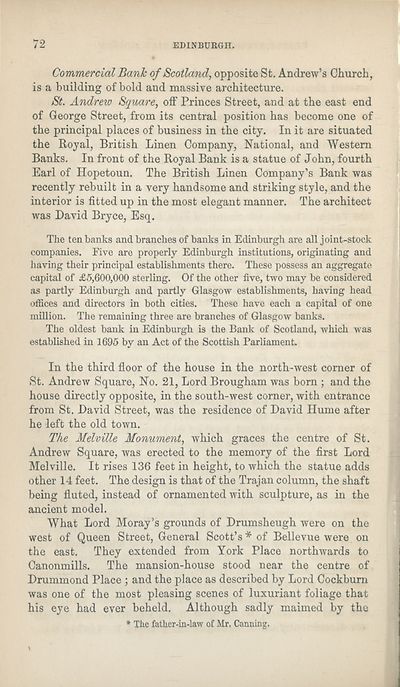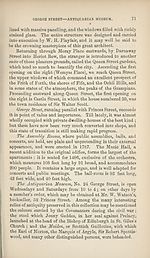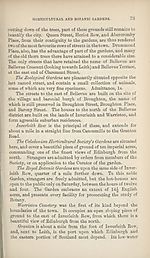Download files
Complete book:
Individual page:
Thumbnail gallery: Grid view | List view

Commercial Bank of Scotland, opposite St. Andrew’s Church,
is a building of bold and massive architecture.
St. Andrew Square, off Princes Street, and at the east end
of George Street, from its central position has become one of
the principal places of business in the city. In it are situated
the Royal, British Linen Company, National, and Western
Banks. In front of the Royal Bank is a statue of John, fourth
Earl of Hopetoun. The British Linen Company’s Bank was
recently rebuilt in a very handsome and striking style, and the
interior is fitted up in the most elegant manner. The architect
was David Bryce, Esq.
The ten banks and branches of banks in Edinburgh are all joint-stock
companies. Five are properly Edinburgh institutions, originating and
having their principal establishments there. These possess an aggregate
capital of £5,600,000 sterling. Of the other five, two may be considered
as partly Edinburgh and partly Glasgow establishments, having head
offices and directors in both cities. These have each a capital of one
million. The remaining three are branches of Glasgow banks.
The oldest bank in Edinburgh is the Bank of Scotland, which was
established in 1695 by an Act of the Scottish Parliament.
In the third floor of the house in the north-west corner of
St. Andrew Square, No. 21, Lord Brougham was bom ; and the
house directly opposite, in the south-west comer, with entrance
from St. David Street, was the residence of David Hume after
he left the old town.
The Melville Monument, which graces the centre of St.
Andrew Square, was erected to the memory of the first Lord
Melville. It rises 136 feet in height, to which the statue adds
other 14 feet. The design is that of the Trajan column, the shaft
being fluted, instead of ornamented with sculpture, as in the
ancient model.
What Lord Moray’s grounds of Drumsheugh were on the
west of Queen Street, General Scott’s* of Bellevue were on
the east. They extended from York Place northwards to
Ganonmills. The mansion-house stood near the centre of
Drummond Place ; and the place as described by Lord Cockbum
was one of the most pleasing scenes of luxuriant foliage that
his eye had ever beheld. Although sadly maimed by the
* The father-in-law of Mr. Canning.
is a building of bold and massive architecture.
St. Andrew Square, off Princes Street, and at the east end
of George Street, from its central position has become one of
the principal places of business in the city. In it are situated
the Royal, British Linen Company, National, and Western
Banks. In front of the Royal Bank is a statue of John, fourth
Earl of Hopetoun. The British Linen Company’s Bank was
recently rebuilt in a very handsome and striking style, and the
interior is fitted up in the most elegant manner. The architect
was David Bryce, Esq.
The ten banks and branches of banks in Edinburgh are all joint-stock
companies. Five are properly Edinburgh institutions, originating and
having their principal establishments there. These possess an aggregate
capital of £5,600,000 sterling. Of the other five, two may be considered
as partly Edinburgh and partly Glasgow establishments, having head
offices and directors in both cities. These have each a capital of one
million. The remaining three are branches of Glasgow banks.
The oldest bank in Edinburgh is the Bank of Scotland, which was
established in 1695 by an Act of the Scottish Parliament.
In the third floor of the house in the north-west corner of
St. Andrew Square, No. 21, Lord Brougham was bom ; and the
house directly opposite, in the south-west comer, with entrance
from St. David Street, was the residence of David Hume after
he left the old town.
The Melville Monument, which graces the centre of St.
Andrew Square, was erected to the memory of the first Lord
Melville. It rises 136 feet in height, to which the statue adds
other 14 feet. The design is that of the Trajan column, the shaft
being fluted, instead of ornamented with sculpture, as in the
ancient model.
What Lord Moray’s grounds of Drumsheugh were on the
west of Queen Street, General Scott’s* of Bellevue were on
the east. They extended from York Place northwards to
Ganonmills. The mansion-house stood near the centre of
Drummond Place ; and the place as described by Lord Cockbum
was one of the most pleasing scenes of luxuriant foliage that
his eye had ever beheld. Although sadly maimed by the
* The father-in-law of Mr. Canning.
Set display mode to:
![]() Universal Viewer |
Universal Viewer | ![]() Mirador |
Large image | Transcription
Mirador |
Large image | Transcription
| Antiquarian books of Scotland > Scotland/Scots > Black's picturesque tourist of Scotland > (124) |
|---|
| Permanent URL | https://digital.nls.uk/130029678 |
|---|
| Description | Thousands of printed books from the Antiquarian Books of Scotland collection which dates from 1641 to the 1980s. The collection consists of 14,800 books which were published in Scotland or have a Scottish connection, e.g. through the author, printer or owner. Subjects covered include sport, education, diseases, adventure, occupations, Jacobites, politics and religion. Among the 29 languages represented are English, Gaelic, Italian, French, Russian and Swedish. |
|---|

